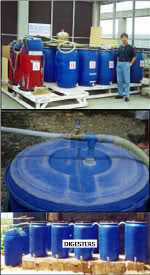 It is true that one man’s junk is another man’s treasure. In agriculture, farm wastes such as rice straw, bio-solids from vegetables, grasses, biodegradable feedstock, and manure do not immediately find themselves into the garbage as they could be potential alternative sources of fuel energy.
It is true that one man’s junk is another man’s treasure. In agriculture, farm wastes such as rice straw, bio-solids from vegetables, grasses, biodegradable feedstock, and manure do not immediately find themselves into the garbage as they could be potential alternative sources of fuel energy.
These agricultural wastes are being converted into biogas fuel through an anaerobic process. Biogas comprised primarily of methane and carbon dioxide which could be used as fuel for generating electricity at homes and farms particularly in remote areas in the province where electricity is limited. These could also be burned directly for cooking, heating, lighting and process heat, and absorption refrigeration.
One question remains. How to generate biogas fuel from these agricultural wastes?
Introducing the portagas
The portable biogas generator or portagas was developed by a group of researchers from the Bureau of Soils and Water Management (BSWM) lead by Dr. Rogelio Concepcion and Dr. Gina Nilo with Mr. Alan Anida, Mr. Carlos Serrano, Ms. Leonora de Leon, and Mr. Victorcito Babiera.
The feasibility and development of the portagas were undertaken for five years, from 2001 to 2006.
According to Dr. Nilo, all common biogas generators have two main parts: digester (where the slurry is mix and fermented to produce the gas); and gas holder (where the gas is collected and connected to a burner for cooking or lamp for lighting).
Prior to the development of the portagas, BSWM developed four biogas generators.
The first ever model is an integrated batch type generator developed in 2000. It is called “integrated batch type” because the gas holder is not separated from the digester.
In 2001, it was modified into a split-batch type (digester and gas holder are separated) and was referred to as PortaGas Model-1 or Pm-1. It has a floating gas holder attached to a Bunsen burner for cooking.
The previous model was further developed with the coming of Pm-2 in 2002 using a surplus burner from a non-functional auto-ignition LPG stove.
Then, a more refined model, Pm-3 was developed in 2003 with a pre-fabricated cast-iron manual gas stove and simplified gas holder fittings.
Finally, the most simplified model, Pm-4, which is the upshot of the portagas.
Recycled drums fixed with necessary fittings were used as the digesters and gas holders for the portagas.
A unit of the portagas consists of 10-drum digesters and two sets of gas holders. Each gas holder is made up of two drums, one for the water and another for the gas.
According to Dr. Nilo, this floating type gas holder, which serves as the pressure regulator, is the “heart” of this generator.
Deriving biogas from agri waste
While the floating gas holder serves as the “heart” of the generator from which the gas is being accumulated, the agricultural wastes serve as the “nub” or the meat of the generator wherein the biogas will come from.
For the portagas, BSWM utilized farms wastes (fresh rice straw and animal manure) and urban wastes (vegetables and fruits refused, grasses and ornamental plant trimmings) to convert into biogas.
These agri-wastes are collected and loaded into the drums. This makes up two thirds of the loaded drum after which, the animal manure and water were mixed into the container. The drum was then compressed with a concrete hollow block, which served as weights on top of the mixture. The drum was sealed and left for several days to digest and ferment.
Gas was discharged from the collectors after 14 days. On the 15th day, a burner maybe attached for the initial flame test.
It is advised not to conduct flame test directly from the gas collectors’ nozzle to avoid accident. A secondary hose must be inserted from the gas collector’s nozzle onto the burner before conducting flame test.
The agricultural wastes inside the drums are to be unloaded after three months.
After the trial, the study showed that the agri wastes charged into the portagas were able to produce 25 cubic meter of biogas fuel which is equivalent to one cylinder of LPG (11 kg).
A cylinder of LPG is the approximate fuel consumption of a typical Filipino family for two and a half months.
Results also showed that biogas emission consistently increases within the first three weeks and fluctuates within the next five weeks. Emission of biogas dwindles after the fifth week due to the declining amount of carbon in the substrate.
The “zero waste” factor
Developing the portagas is said to be a “zero waste” endeavor because the digested agricultural waste which was unloaded from the drums now becomes the by-products which will then serve as compost for soil fertility enhancement.
In the study trial conducted, among the by-products collected were: 98.5 kg of compost and 750 liters of organic liquid fertilizer.
Results showed that the nitrogen (N) content of the compost increased from 0.6% in fresh rice straw to 1.5%.
According to Dr. Nilo, this is equivalent to two bags of organic fertilizer. Also, the digested compost from biogas generation contributed greatly in crop production and in mitigating the methane gas greenhouse effect.
Benefit-cost analysis of the portagas showed that return of investment (ROI) starts after the 12th cycle.
———
This article was based on the study, “Design, Fabrication and Calibration of a Portable Biogas Generator (Portagas)” by Dr. Rogelio Concepcion, Dr. Gina Nilo, Mr. Alan Anida, Mr. Carlos Serrano, Ms. Leonora de leon, and Mr. Victorcito Babiera of the Bureau of Soils and Water Management (BSWM), Elliptical Road, cor. Visayas Avenue, Diliman, Quezon City, Philippines.
For more information please contact the project leader, Dr. Gina Nilo, chief of the Soil and Water Resources Research Division (SWRRD), BSWM at telephone number (02) 920-4378.
Article by Rita T. dela Cruz- bar.gov.ph, April-June 2007 Volume 9 Issue No. 2
Photo: BSWM
Do you like this business ideas for entrepreneurs? then please consider subscribing to our RSS feed and have new business ideas sent directly to your inbox. (Once you entered your e-mail address, you need to login to your e-mail account and click the link to confirm your subscription).




Hi. I am starting a piggery farm in leyte with my wife and family. We are interested in your biogas generator and we would like to know the
cost of setting one up
I have a small pig farm & I’ m interested in biogas production to be able to help in a small way to a clean environment.
Do you still.sell this bio gas digester?
How is d 3000 watts biogas generator?..
how much is the price?
OUR CO. is selling biogas GENERATOR SETS AT FACTORY PRICE.. JUST PM ME…
how much the cost price of one set of biogas GENERATOR SET AT FACTORY PRICE…
I never thought that it is possible to produce potential alternative sources of fuel energy from agricultural wastes. This could be very helpful for the environment and and we people could also benefit with it. Thank you for a very informative post.